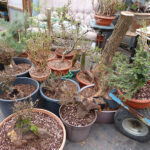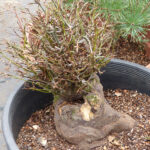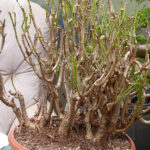It’s been insanely busy so far this year and everyone was getting a bit ragged so I declared a day off. However instead of loafing around in front of the TV, Rammon and I headed out to the woods. Sadly our collecting is pretty tame compared to what some of our friends enjoy but, we had a nice day out all the same. Here are a few of the trees we collected.
Among others there are larch, hawthorn, beech, yew, scots pine, elm and some very unusual tillia (Linden).
G.





Hi Graham and Ramon,
In the second picure (central) there is a tall bare trunk, larger than the rest; is it a yew? In the past I have collected yews with very little foliage in March and they have budded straight from the trunk, and this year I collected what I hope will be one of the grand old trees of my life, this time a foliage-free trunk of Taxus bacata with a great root ball. I have high hopes of it surviving, and even think I see buds developing, but as yet very small. Some on the intenet think that Yew must have foliage to survive collecting, and I now begin to wonder if I am wrong. What is your experience in this area?
Regards,
Matt
The significant factor when collecting yew is to ensure that after removal the rootball is kept dry. This prevents rotting of the soft white roots. Also keeping very warm in a greenhouse will bump it up a lot. Recovery is faster if the tree has foliage but bare trees will survive just fine if treated as above. Removing the apical parts of any taxus will severely reduce it’s sap low (and recovery) but it’s not normally possible for us to retain that part. A healthy taxus should grow a minimum of 24″ a year. We leave alone until we see that sort of progress.
Thanks, that’s reassuring. The tree is in 100% moler, and the soil it was dug from is so laomy that it all fell free of the root ball with ease, so the fleshy roots ought not to be at risk. The tree’s in a sheltered sunny spot too so that should bring it on (no greenhouse available saddly).
Hi
Moler is a bad idea, alone it holds way too much moisture (over 100% of it’s own weight) and it is about 100x too acidic for a taxus. Moler should never be used alone it needs to be combined with other products to engineer the perfect soil.
G.
Graham,
This is a supprise to me, I’ve been using moler with just a little coconut fibre and bark for all my trees for five years and they all seem in good health, but you have much more experience than me so I am sure your right. Unfortunately, I just don’t have the money to replace the substrate with something else right now!
This will be a painful learning experience if the tree fails, most sad, but thanks for the advice anyway: I will reconsider my use of substrate next year.
Matt
I recently purchased 2 Quercus subar (Med oak) from your company) the leaves are turnig brown and the tree is now having leaf fall having grown bonsai for more than 20yrs this is knew to me albeit it is the first time I have this type of bonsai. Your comments a.s.a.p. as im worried it might have an effect on my private collection of more than 40 bonsai trees.
Mr G McMillan
In this wet and cold weather of spring 2012, I repotted several pines (2 parviflora, densiflora, cembra and mugo). I don’t know if a late spring (and very very wet, it’s been three weeks it rains constantly here in Switzerland …) can be bad for the pine trees that like to dry. Anyway, I am pleased to see the trees in my garden and also take off with the arrival of the sun planned for this weekend!
Very great website, you’ve never thought about doing a video on the current materials that you worked? (I am very curious of scot pine “how hard can it be?”)
having read my email sent to you I ommitted that this browning of leaves was taking part in the month of January and leaf fall in March.
G